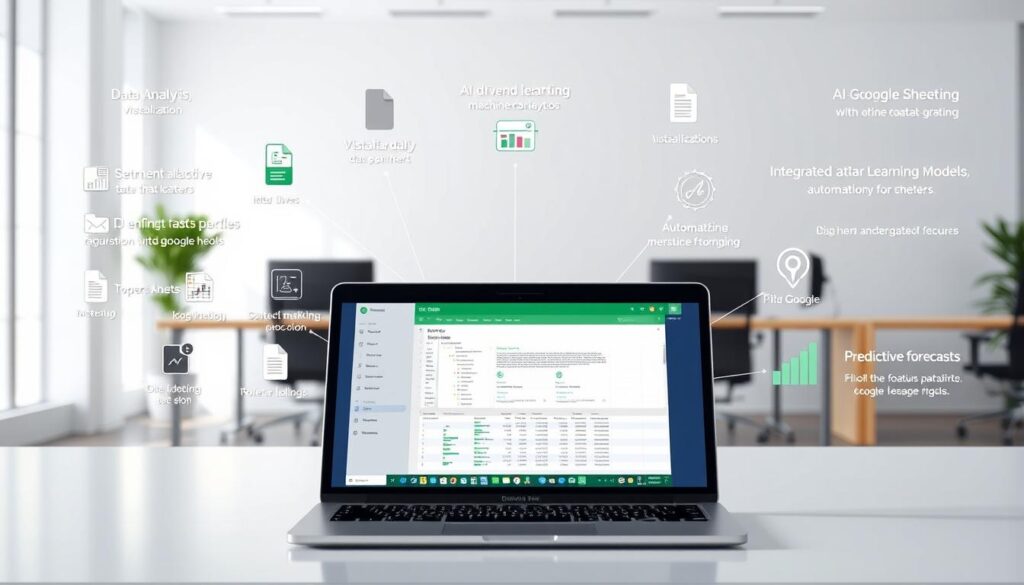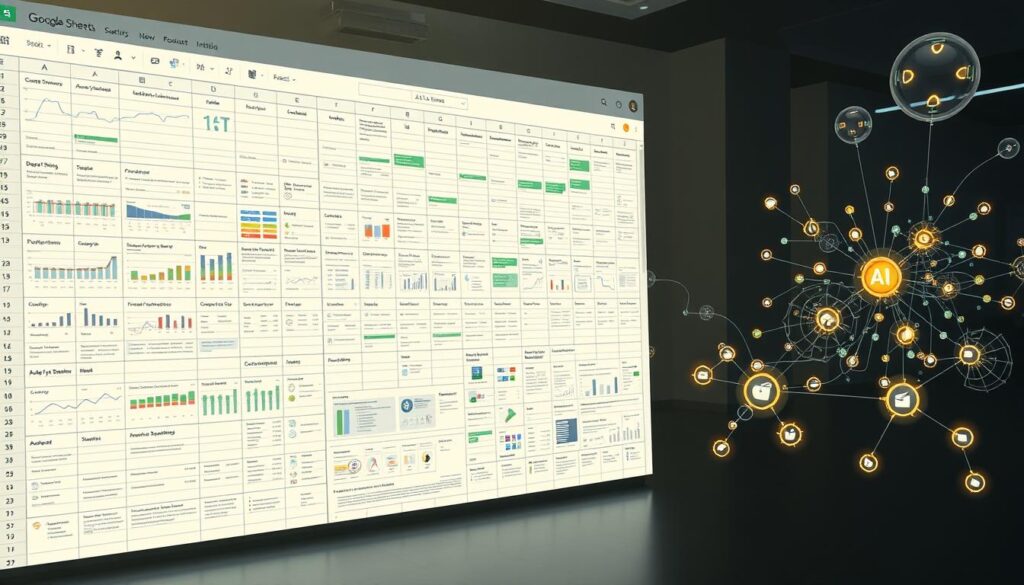Google Sheets workflows often struggle with manual data entry, slow updates, and errors. AI tools for Google Sheets solve these problems by automating tasks. They make Google Sheets work better by importing data in real-time and doing advanced analytics.
Professionals get insights faster, saving time and making fewer mistakes. This makes work more efficient and accurate.

This guide shows how AI can improve your workflow. It talks about tools that make data syncing, predictive modeling, and team analysis easier. You’ll learn how to pick the best technology for your business.
It ensures your new tools work well with what you already have. The next parts will show you how to turn old manual processes into smart, automated ones.
Understanding How AI Enhances Google Sheets Functionality

Google Sheets AI integration brings features once thought of as science fiction. Old tools needed manual input, but today’s tools do complex tasks automatically.
The Evolution of Spreadsheet Automation
Old spreadsheet tools used simple formulas and macros. But now, AI and machine learning for spreadsheets help solve tough problems. They do things like analyze data in real time and spot patterns.
Companies use these tools to predict trends, improve workflows, and cut down on manual work.
Key Benefits of AI Integration with Google Sheets
- Time savings: Automating data entry saves hours on repetitive tasks.
- Error reduction: AI finds mistakes, reducing human errors.
- Predictive analytics: Machine learning makes forecasts from past data.
- Automated reporting: Dashboards update automatically, no need for manual updates.
Common Use Cases for AI-Powered Google Sheets
Finance teams use AI to spot fraud. Marketing teams analyze campaign success with AI tools. HR teams automate screening with data cleaning.
For example, a retail company might predict inventory needs with AI. A nonprofit could track donations in real time. These examples show how benefits of AI spreadsheets apply across different fields.
Top AI Tools for Connecting Google Sheets
Choosing the right best Google Sheets AI tools can change how you work with data. Here’s a list of top solutions to make your work easier and more productive:
- Zapier: A data automation plugins leader, Zapier connects Google Sheets with over 5,000 apps. It automates tasks like data imports or email notifications without coding.
- Tiller: Great for tracking finances, Tiller uses spreadsheet AI connectors to manage budgets and expenses. It has custom templates to make bookkeeping easier.
- Obviously AI: Turn raw data into insights with natural language queries. This Google Sheets integration tools option lets users ask questions directly in their sheets.
- CAIOT’s AI Sheets: Add machine learning models to Google Sheets for predictive analytics. No advanced coding required—perfect for forecasting and trend analysis.
New tools like spreadsheet AI connectors from niche developers meet specific needs, like CRM data sync or real-time dashboard updates. Look at features like pricing tiers (free to enterprise), ease of setup, and compatibility with your workflows. Whether you’re a no-code user or a developer, these solutions help bridge the gap between raw data and useful insights.
Implementing AI Solutions to Transform Your Spreadsheet Workflow
Make your Google Sheets smarter with AI. Follow these steps to boost productivity and accuracy. Use Google Sheets AI implementation and spreadsheet workflow automation to improve your workflow.
Setting Up Your First AI-Google Sheets Connection
Start by picking an AI tool like AutoCrat or Data Studio. Here’s how to begin:
- Enable API access in your Google account settings.
- Connect the tool via OAuth 2.0 authentication. Example:
function setupAPI() { ... } - Map data fields and test the integration with sample data.
Overcoming Common Integration Challenges
Face common issues like data format mismatches or slow sync speeds. Try these solutions:
- Data formatting: Standardize date/time formats before import.
- Sync issues: Use batch processing to reduce API call limits.
- Performance lag: Optimize queries with filters or caching.
Advanced Techniques for Data Analysis and Visualization
Learn AI data analysis techniques like predictive analytics. Apply these methods:
- Prediction models: Use LINEST() for trend forecasting.
- Anomaly detection: Flag outliers with conditional formatting rules.
- Visualization: Embed charts using Data Studio for dynamic dashboards.
Security Considerations
Keep data safe with spreadsheet data security best practices:
- Enable two-factor authentication for all user accounts.
- Encrypt sensitive sheets using Google Drive’s Vault feature.
- Regularly audit API access logs for unauthorized activity.
Conclusion: Maximizing Productivity with AI-Enhanced Google Sheets
Using AI in Google Sheets boosts AI productivity enhancement and Google Sheets efficiency. It automates tasks, analyzes data, and offers insights. This turns spreadsheets into tools for innovation.
The future of spreadsheet automation looks bright. AI will get smarter, adapting to users’ needs instantly. It will handle complex tasks and improve data analysis and teamwork.
Start with pre-built templates for beginners. Advanced users can try custom scripting. Choose tools that fit your goals, like Datawrapper for data visualization or Kaggle for predictive modeling.
Always check how AI handles data to keep it safe. This is crucial when using AI tools.
Begin with a simple project to test AI tools. Try an add-on for auto-categorizing data or making charts. Small steps help build confidence in using AI.
Keep up with updates from Google and developers. This will help you stay current with new AI features.
See AI as a partner, not a replacement. It helps with tasks like budgeting and forecasting. AI lets you focus on creativity and making decisions. Start your journey to smarter workflows today.